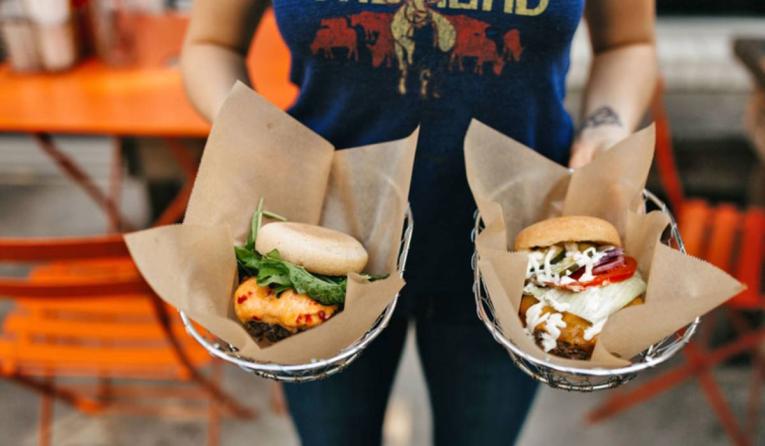Getting flexible
Even prior to 2020, New England–based Oath Pizza practiced the idea of doing more with less, something that has proved especially advantageous as of late.
“Oath has always been selective about the products and the menu we offer. Through some really thoughtful selection and cross-utilization, we’ve been able to put together a menu that caters to all tastes,” says Pam McMorrow, director of supply chain and product innovation. Indeed, the fast casual offers vegetarian, plant-based, gluten-free, and dairy-free options. “Another piece of it is we’re really mindful about the impact on the planet when we’re making our decisions on what we bring in,” she adds, offering Oath’s use of humanely raised Applegate proteins and recyclable packaging for non-pizza dishes as examples.
But even the versatility of Oath’s ingredients couldn’t shield it from gridlocks along the supply chain.
“The biggest things were product deliveries being delayed and complete product outages; if it wasn’t coming in late, it wasn’t coming in at all,” McMorrow says. “We had to find alternative methods for deliveries like direct shipments or drop shipments straight from the manufacturers.”
She adds that thanks to a nimble team, Oath has been able to take many of these disruptions in stride. Like Rubio’s, it also sought alternatives to products that were tied up in transit or unavailable. In many cases, the substitutes were closer to home.
Before COVID, about 75–80 percent of its products were domestically produced since Oath would import some specialty items, like gourmet cheeses, from overseas. Now, McMorrow estimates the portion has grown to 95 percent. The switch also saved money by eliminating trade tariffs and shortening the shipping distance. Through it all, the brand was able to maintain its standards; as a bonus, the less time in transit also translated to a fresher product with a longer shelf life.
McMorrow says the final piece was turning to creative workarounds with ingredients that, while still fresh and high quality, might not be what was needed. For example, if crusts arrived that weren’t the right size for a pizza, the restaurants would cut them into squares and use them as croutons on the caesar salad.
“We put laser focus on product inventory—or par levels—based on accurately forecasted sales, and we completely tightened up our purchasing practices to bring in only the amount of product needed,” she says. “By doing that, we reduced the amount of stock in our restaurants and the amount of product in the supply chain. It also reduced the risk of having extra that could go to waste.”
Broadline adjustments
Distributors are also adopting a repurpose mentality. In late March, US Foods became one of the first major broadline food distributors to join the Upcycled Food Association, an organization whose members salvage ingredients bound for landfills and incorporate them into food products.
US Foods’ first foray into upcycling is the Hilltop Hearth Pub Grain Hamburger Bun, which uses spent grain flour. A byproduct of beer brewing, spent grains not only find new life as flour, they also infuse the buns with a mild, earthy, and sour flavor.
One area of sustainability that McMorrow says tends to be overlooked are the chemicals used along the supply chain and in the restaurants.
“I don’t think people realize how damaging it can be if you’re using the wrong products, how damaging it can be to just pour it down the drain. That drain goes directly to our water supplies in some cases or watersheds, and it’s not often thought about,” she says. “Restaurants have to do their homework on those choices; you have to know what’s in these chemicals and how their contents affect the environment.”
In addition to third-party accreditation groups, manufacturers and distributors are creating their own initiatives as a way of vetting products for their restaurant clients. At US Foods, this culminated in the Serve Good program, which launched in 2016. To be part of Serve Good, products must not only have claims of sustainable sourcing or waste reduction, they must also arrive in eco-friendly packaging.
Because so many factors are involved in meeting the criteria, US Foods divided them into five categories: agricultural practices, sustainable seafood, animal care, responsible disposables, and waste reduction.
“Almost all of the products under the Serve Good umbrella have the reassurance of some third-party certifier. So we’re working with Non-GMO Project Verified, USDA Organic, Marine Stewardship Council, Forest Stewardship Council,” says Hannah Koski, director of corporate social responsibility at US Foods. “Some of these third party certifications have a long history, but then others are new, and we’re excited to be able to incorporate those as well.”
In just six years, Serve Good has quadrupled the number of products (under US Foods Exclusive Brands) in its stable to 770.
The broadline distributor is also making strides in how these items are transported. In California, its distribution centers are moving to 100 percent renewable diesel. In Texas, it’s converting compressed natural gas trucks to use renewable natural gas fuel. US Foods is also bringing 15 electric trucks into the fold. All three agenda items are slated to be completed by year-end.
“How [a product] is delivered is also really important,” Koski says. “We flagged a lot of initiatives both in our buildings and in our routes to improve our efficiency and reduce our environmental impact overall.”


